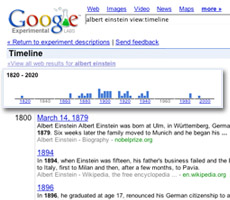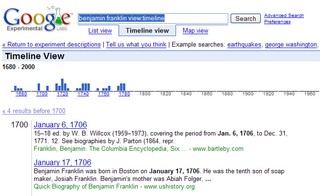 A year ago I wrote a recipe for the TAPoR project to demonstrate a way for historians to utilize text analysis tools to plumb historical data from Google. In the recipe a user aggregated search results from Google and used the TAPoR DateFinder tool to rapidly construct a chronology. This rather basic operation has now been automated by the folks at Google labs. Now, with the simple addition of two words in your search request you can choose to view the familiar text search results in two exciting additional contexts, temporal and spatial. The new Google Timeline and Map views is a powerful but simple tool for historians and others as well.
A year ago I wrote a recipe for the TAPoR project to demonstrate a way for historians to utilize text analysis tools to plumb historical data from Google. In the recipe a user aggregated search results from Google and used the TAPoR DateFinder tool to rapidly construct a chronology. This rather basic operation has now been automated by the folks at Google labs. Now, with the simple addition of two words in your search request you can choose to view the familiar text search results in two exciting additional contexts, temporal and spatial. The new Google Timeline and Map views is a powerful but simple tool for historians and others as well.
The process is fast and very intuitive. You supply a name as search term and specify the timeline view. ‘benjamin franklin view:timeline’ returns the following screen:

Their routines cleans up the search results and plots them visually on a timeline by number of results returned by year. The search returns are organized chronologically below the timeline can be selected to go to explore each event in greater detail. You can drill down visually to increase granularity by clicking on timeline itself.
Additionally, a GoogleMaps mashup is instantly available and plots the same search results on a map. Search results are winnowed to identify both dates and locations and retained in your results if they contain either. This obviously raises serious issues of bias, but from a quick and dirty starting point, these are left to you to judge.
The presentation of this product is very similar to Exhibit from SIMILE. However, where this Google tool allows you to scavenge public data, the SIMILE product is a very handy framework to present your own information in without relying on complex server configuration. Both demonstrate the visualization potential that simple tools offer historians. Chronological visual presentation is probably the more familiar aspect. The opportunity to rapidly construct a spatial view on a Google map is less used, but amazingly valuable.
The addition of such a simple tool to the historians kitbag offer tremendous new opportunities to explore historical data from new vantage points.
